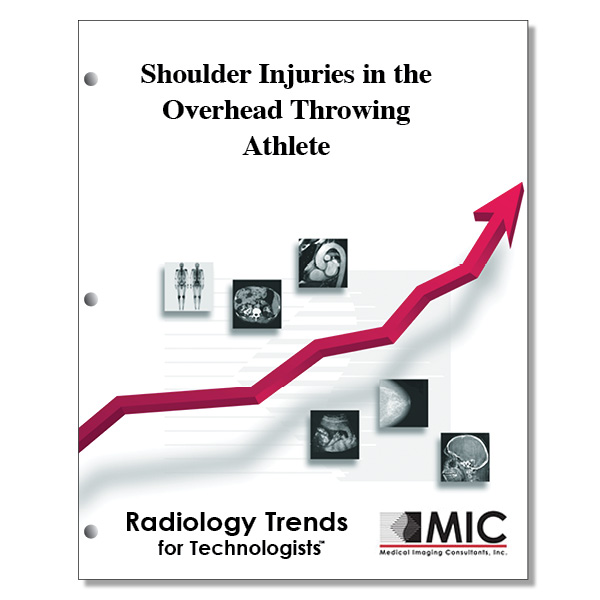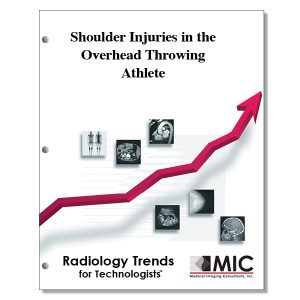

Shoulder Injuries in the Overhead Throwing Athlete
The epidemiology and biomechanics of throwing injuries and unique imaging findings seen in overhead athletes are presented.
Course ID: Q00569 Category: Radiology Trends for Technologists Modalities: MRI, Radiography3.0 |
Satisfaction Guarantee |
$34.00
- Targeted CE
- Outline
- Objectives
Targeted CE per ARRT’s Discipline, Category, and Subcategory classification for enrollments starting after December 10, 2024:
[Note: Discipline-specific Targeted CE credits may be less than the total Category A credits approved for this course.]
Computed Tomography: 0.50
Procedures: 0.50
Head, Spine, and Musculoskeletal: 0.50
Magnetic Resonance Imaging: 1.25
Image Production: 0.25
Sequence Parameters and Options: 0.25
Procedures: 1.00
Musculoskeletal: 1.00
Radiography: 0.50
Procedures: 0.50
Extremity Procedures: 0.50
Registered Radiologist Assistant: 1.50
Procedures: 1.50
Musculoskeletal and Endocrine Sections: 1.50
Sonography: 0.50
Procedures: 0.50
Superficial Structures and Other Sonographic Procedures: 0.50
Outline
- Introduction
- Epidemiology
- Throwing Biomechanics
- Phases of Throwing
- Achieving Maximum External Rotation
- The Total Arc of Motion
- Consequences of Adaptive External Rotation
- GIRD
- Internal Impingement
- Rotator Cuff Tears
- Labral Tears
- Anterior Shoulder Injuries
- Anterior Capsule Injury
- Subscapularis Tendon Injury
- Lesser Tuberosity Injuries
- Posterior Shoulder Injuries
- Bennett Lesion
- Posterior Muscle Injuries
- Specific Overuse Injuries
- Proximal Humeral Epiphysiolysis (Little League Shoulder
- Glenoid Osteochondral Injury
- Shoulder Injuries in Overhead Sports Other than Baseball
- Technical Considerations
- MR Imaging
- US and CT
- Conclusion
Objectives
Upon completion of this course, students will:
- state the fastest athletic movement performed in sports
- recall what sport has been the most widely studied for repetitive overhead activity
- cite the number of players in the United States that play recreational baseball
- list the number of youth league, high school, collegiate, minor league and major league baseball players
- recall the number of activity-related shoulder injuries that occur annually in Little League baseball players
- identify the baseball player position most affected by shoulder injuries
- name the time frame of the baseball season when most MLB shoulder injuries occur
- compare injury statistics of rookie and veteran minor league baseball players
- state the number of established phases of throwing in baseball
- list in order the throwing phases in baseball
- recall the most important phases of throwing which are pertinent to shoulder injuries
- describe the body position during maximum external rotation during the arm cocking phase of throwing
- explain which muscles achieve maximum activity during the acceleration phase of throwing
- state the throwing phase that imparts the greatest glenohumeral joint loading
- recall the force during the deceleration phase of throwing
- describe the action during the final phase of follow-through
- state the ball velocity in elite pitchers
- recall the most important determinant of ball velocity
- explain osseous adaptions and their relationship to increased external rotation
- define humeral retrotorsion
- define the total arc of motion
- review the cause of most shoulder injuries
- define glenohumeral internal rotation deficit
- recall what a SLAP tear is
- state the most common cause of shoulder pain in throwers
- share radiologist interpretation pitfalls as related to internal impingement
- match “tear of necessity” to posterosuperior rotator cuff tears
- recall the positions where labral tears may occur
- list the number of SLAP tears
- denote the sensitivity of diagnosing SLAP tears on conventional MR images
- describe how patients with anterior capsular tear present clinically
- describe how MR can be used to evaluate lesser tuberosity injuries
- state the alternate name for a Bennett lesion
- list the combined functions of the latissimus dorsi and teres major muscles
- state when non-surgically treated posterior shoulder injury patients typically return to pre-injury level of play
- know the age range for the presentation of Little League shoulder
- list treatments for glenoid osteochondral defects
- state percentage of shoulder injuries in tennis causing the athlete to leave the sport
- recall the preferred imaging modality for soft tissue shoulder injuries
- know what imaging modality is becoming more available at baseball stadiums
